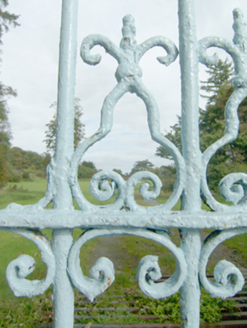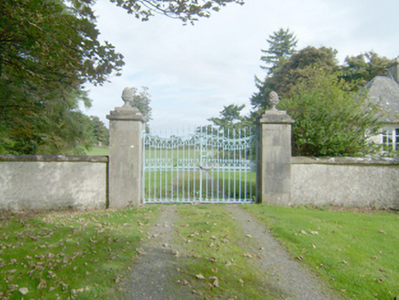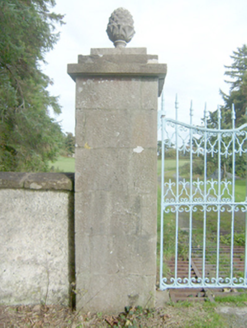Survey Data
Reg No
40901618
Rating
Regional
Categories of Special Interest
Architectural, Artistic
Original Use
Demesne walls/gates/railings
In Use As
Demesne walls/gates/railings
Date
1820 - 1860
Coordinates
206248, 436315
Date Recorded
30/09/2010
Date Updated
--/--/--
Description
Main gateway serving Marble Hill (see 40901602), erected c. 1810 or c. 1834 and probably re-erected c. 1895, comprising a pair of hammered ashlar gate piers (on square-plan) having stepped cut stone coping over surmounted by cut stone pineapple finials over, and with a pair of decorative wrought-iron gates. Attendant gate lodge (see 40901617) adjacent to the east. Gateway flanked to either side (east and west) by quadrant sections of roughcast rendered rubble stone boundary walling having cut stone coping over and terminated by piers (on square-plan). Located in the rural countryside to the east\south-east of Dunfanaghy and to the south-east of Marble Hill at start of approach avenue to house. Marble Hill Strand adjacent to the east.
Appraisal
This simple but attractive gateway serves as the main entrance to Marble Hill (see 40901602), and is an appealing feature in the rural landscape to the south-east of Dunfanaghy. It survives in good condition and retains its early form and character. The hammered ashlar gate piers are clearly the work of skilled masons while the intricate wrought-iron gates are fine examples of nineteenth-century metallurgy. This gateway probably originally dates to the first half of the nineteenth century but it appears to have been rebuilt following the construction of the attendant gate lodge to the east (see 40901617), which was built c. 1895 (Ordnance Survey first edition six-inch map sheet of c. 1837 and Ordnance Survey twenty-five inch map of c. 1903/4). Of particular note are the fine cut stone pineapple finials surmounting the piers, which are very finely carved. These finials probably date to the first half off the nineteenth century. Pineapples were a relatively common motif found on the piers on gateways to large country estates (and elsewhere on estates) – particularly in Great Britain and the United States – from the early part of the eighteenth century into the mid-nineteenth century, and was popularly considered a symbol of hospitality. According to tradition the tradition of pineapple finials started with the practice of seafaring captains who impaled a fresh pineapple on their porches to indicate that they had returned home from exotic voyages. The elegant sweeping quadrant walls to either side appear to date to a late nineteenth century rebuilding, and add significantly to the setting and context. This building forms a pair of related structures along with the associated gate lodge to the east, and part of a wider group of structures associated with Marble Hill (see 40901602), and is an integral element of the built heritage of the local area in its own rights.





